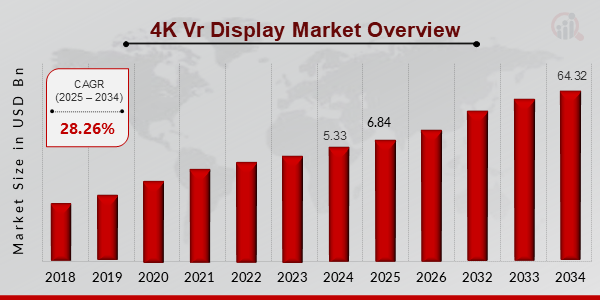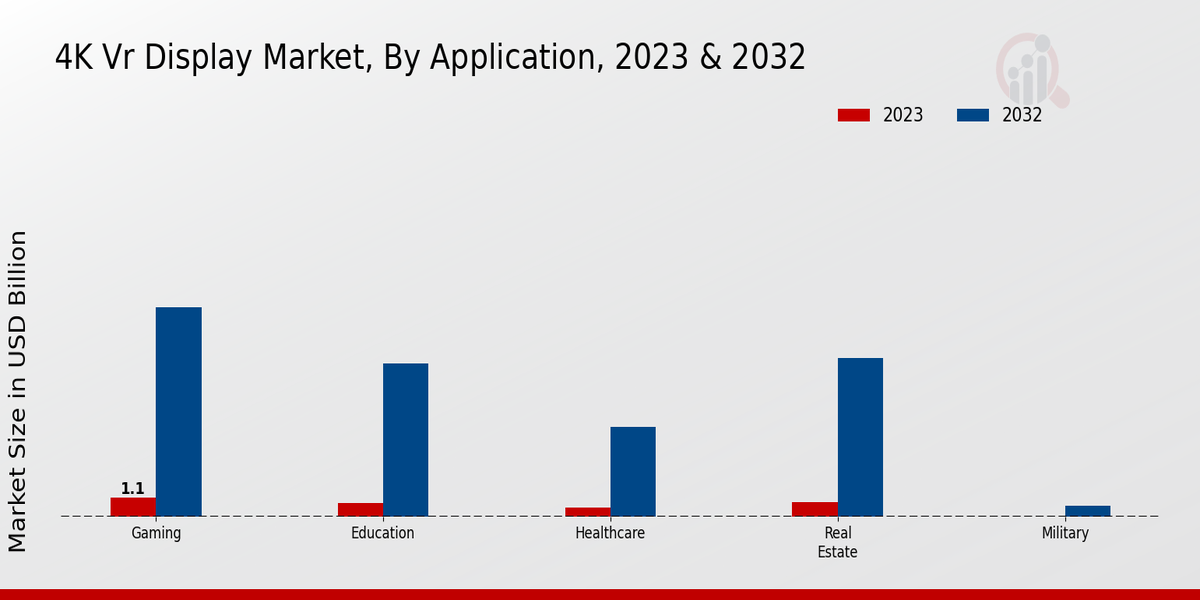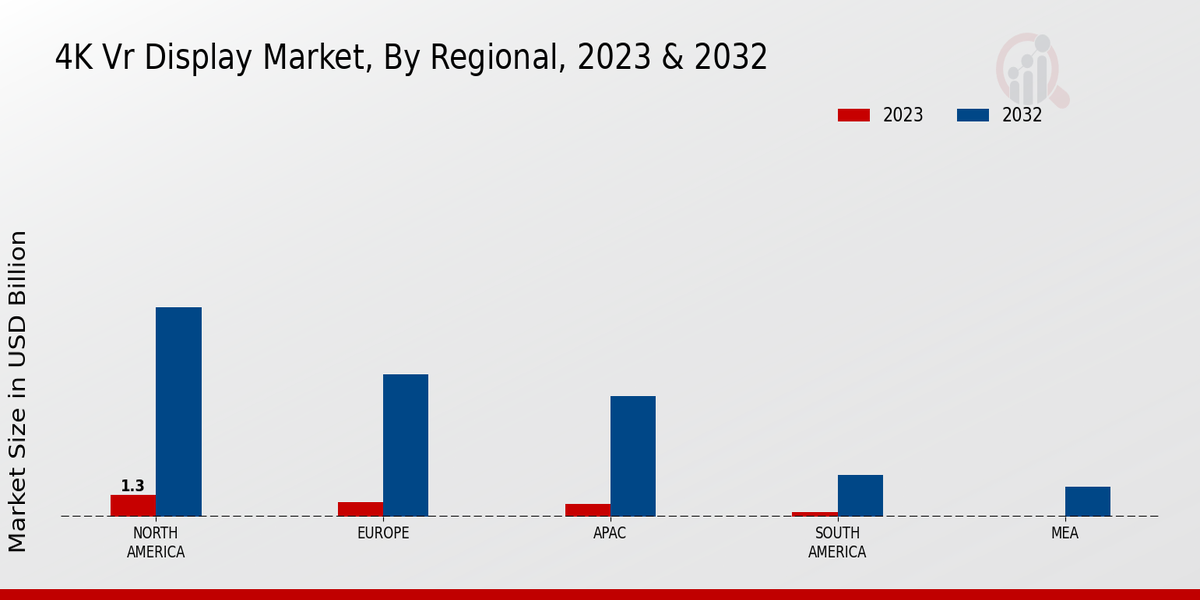4K VR Display Market Overview
4K Vr Display Market is projected to grow from USD 6.84 Billion in 2025 to USD 64.32 Billion by 2034, exhibiting a compound annual growth rate (CAGR) of 28.26% during the forecast period (2025 - 2034). Additionally, the market size for 4K Vr Display Market was valued at USD 5.33 billion in 2024.
Key 4K VR Display Market Trends Highlighted
The 4K VR Display Market is experiencing significant growth driven by advancements in display technology and increasing consumer demand for immersive experiences. Enhanced image quality and resolution provided by 4K displays improve user engagement across various applications, from gaming and entertainment to education and training. The rising adoption of virtual reality in sectors such as healthcare and architecture also fuels market growth. Furthermore, the growing trend of remote work and virtual collaboration is pushing more individuals and businesses to explore VR solutions, leading to an increased need for high-resolution displays.
Opportunities remain abundant as more industries recognize the potential of 4K VR displays to enhance training, design simulations, and interactive experiences. As the technology continues to evolve, there is potential for developments that integrate artificial intelligence and machine learning to create more adaptive and personalized VR experiences. This opens new avenues for innovation in content creation and user interaction, allowing market players to explore niche segments and tailor offerings to meet specific customer needs. Recent times have witnessed a surge in demand for cloud-based VR applications that can deliver 4K content effectively.
This trend highlights the importance of robust connectivity and bandwidth solutions to accommodate high-resolution streaming. Moreover, with more content creators producing VR content at higher resolutions, the emphasis on having compatible and advanced display systems has never been more critical. The shift towards wireless VR solutions also reflects changing consumer preferences, making it easier for users to engage with virtual environments without being tethered to traditional devices. As these trends continue to shape the landscape, the market for 4K VR displays will likely evolve to meet the growing expectations of consumers and industries alike.
Figure 1 4K Vr Display Market Overview (2025-2035)

Source: Primary Research, Secondary Research, MRFR Database and Analyst Review
4K VR Display Market Drivers
Rising Demand for Enhanced Visual Experiences
The growing interest in high-definition visuals and immersive experiences is driving substantial growth in the 4K VR Display Market Industry. As technology advances, consumers are becoming increasingly accustomed to superior picture quality, prompting a demand for 4K virtual reality displays that can accommodate these expectations. This demand is particularly evident in sectors such as gaming and entertainment, where the quality of visual content directly impacts user experience.
Gamers and enthusiasts are seeking out equipment that offers the highest fidelity, including ultra-high-definition resolutions that enhance immersion and realism. Moreover, industries like architecture, visual design, and education are increasingly adopting 4K VR displays for their ability to present intricate designs and environments in vivid detail, fostering creativity and innovation. The proliferation of content specifically tailored for 4K resolutions, such as VR gaming titles and cinematic experiences, further amplifies the appeal of high-resolution displays.
As more brands and developers enter the market, they're focusing on developing advanced technologies that optimize the user experience, making it a key area for investment and growth within the 4K VR Display Market. As such, the convergence of consumer demand and emerging technologies positions this segment for significant growth in the coming years.
Technological Advancements in VR Hardware
The continuous innovation and improvements in virtual reality hardware are significant drivers of growth in the 4K VR Display Market Industry. Recent technological advancements have led to enhanced performance in display quality, processing power, and user comfort, making VR more accessible and appealing to a broader audience. Manufacturers are investing heavily in research and development to produce VR headsets and displays that offer superior resolution and refresh rates, catering to the increasingly sophisticated demands of users. This ongoing technological evolution is creating a plethora of opportunities for VR applications across various sectors, from gaming to training simulations, all contributing to the expanding market.
Growing Adoption in Enterprises and Academics
There is a surge in the adoption of 4K VR displays within corporate and educational settings, significantly bolstering the 4K VR Display Market Industry. Businesses are leveraging VR technology for training purposes, allowing employees to engage in immersive simulations that enhance learning outcomes and boost productivity. Similarly, educational institutions are incorporating VR displays into curricula to provide students with interactive and experiential learning opportunities that foster deeper understanding. This trend highlights the versatile capabilities of 4K VR displays across varied sectors, driving growth through increased usage and investment.
4K VR Display Market Segment Insights
4K VR Display Market Application Insights
The 4K VR Display Market is experiencing substantial growth, particularly in the Application segment, which not only reflects technological advancements but also consumer demand across various sectors. By 2023, the market is valued at approximately 3.25 USD Billion, and this is projected to rise significantly to about 30.5 USD Billion by 2032, showcasing the expansive potential of this industry. Within the Application segment, the Gaming sector stands out as a dominant player, with a valuation of 1.1 USD Billion in 2023, expected to leap to 11.6 USD Billion in 2032.
This rise can be attributed to the increasing popularity of immersive gaming experiences, where high-definition visuals play a crucial role in enhancing player engagement and satisfaction. Education also emerges as a significant segment, valued at 0.8 USD Billion in 2023 and anticipated to reach 8.5 USD Billion in 2032. The trend toward blended learning and virtual classrooms highlights the increasing reliance on VR technology to provide interactive educational experiences, making VR displays vital for modern learning environments. The Healthcare sector, while currently valued at 0.5 USD Billion in 2023, is expected to expand to 5.0 USD Billion by 2032.
Applications in surgical simulations, patient management, and therapy highlight the essential role that 4K VR displays play in healthcare, providing medical professionals with critical visualization tools that combine realism with practical training. Real Estate is another important area of growth, with a market value of 0.85 USD Billion in 2023 that is expected to increase to 8.8 USD Billion by 2032. The integration of VR technology allows buyers to experience virtual property walkthroughs, making it easier to visualize homes and commercial spaces, thus transforming the property market landscape.
Lastly, the Military segment, although currently valued at 0.0 USD Billion in 2023, is projected to reach 0.6 USD Billion by 2032. The adoption of immersive displays for training simulations and strategic planning emphasizes the potential importance of VR technology in defense operations. Overall, the 4K VR Display Market segmentation reflects substantial opportunities across various domains, driven by increasing technological capabilities and evolving consumer needs, making it a critical focal point for future investments and developments.
Figure 2 4K Vr Display Market By Application (2023-2032)

Source: Primary Research, Secondary Research, MRFR Database and Analyst Review
4K VR Display Market Display Type Insights
The 4K VR Display Market has shown significant growth, with a market valuation reaching approximately 3.25 USD Billion in 2023. This market encompasses various Display Type technologies, which are crucial in enhancing the overall viewing experience in virtual reality environments. OLED technology plays a significant role due to its superior color accuracy and high contrast ratios, which are essential for immersive visuals. Meanwhile, LCD continues to dominate owing to its wide availability and cost-effectiveness, appealing to a broader consumer base.
LCD with LED Backlighting is noteworthy for its improved brightness and energy efficiency, making it an attractive choice for many applications. DLP technology is recognized for its reliable performance in projection, contributing to its relevance in larger display setups. MicroLED, being an emerging technology, is gaining traction for its exceptional color gamut and scalability, positioning it as a future leader in the 4K VR Display landscape. The market's progression reflects the ongoing trends of innovation, energy efficiency, and consumer demand for high-quality visual experiences, driving the overall market growth and segmentation in this dynamic sector.
4K VR Display Market End-Use Insights
The 4K VR Display Market, with an expected valuation of 3.25 USD Billion in 2023, showcases diverse potential across various end-use categories, including Consumer, Commercial, and Industrial sectors. The Consumer segment plays a crucial role in driving market growth as the demand for immersive entertainment experiences, gaming, and virtual social platforms continues to rise. The Commercial segment is also significant, encompassing applications in education, training, and marketing, where engaging visuals enhance learning and communication processes.
Meanwhile, the Industrial sector is witnessing increasing adoption of 4K VR technology for simulation and design, which optimizes workflows and reduces costs. Together, these end uses contribute substantially to the 4K VR Display Market revenue, reflecting a robust market growth trajectory supported by ongoing technological advancements and increasing consumer awareness. As of 2032, the market is set to grow phenomenally, reflecting a booming industry where the integration of augmented realities into everyday tasks is becoming vital, thus presenting abundant opportunities for stakeholders. The overall 4K VR Display Market Statistics emphasize the essential role these end-use categories play in establishing a competitive landscape.
4K VR Display Market Technology Insights
The 4K VR Display Market, valued at 3.25 USD Billion in 2023, is experiencing significant growth driven by technological advancements and increasing consumer demand for high-quality immersive experiences. This market is characterized by its diverse technology options, which include Holographic Display, Flat Panel Display, and Stereoscopic Display, among others. Holographic displays are gaining traction due to their ability to create a three-dimensional experience without the need for glasses, enhancing user engagement. Flat panel displays, known for their widespread application across various devices such as smartphones and tablets, continue to dominate the market owing to their affordability and accessibility.
Meanwhile, stereoscopic displays are critical for offering depth perception, making them popular in the gaming and entertainment sectors. As the demand for virtual reality content surges, these technologies collectively enhance the overall user experience, influencing the 4K VR Display Market statistics and driving rapid adoption across industries. Furthermore, the market reveals various growth drivers, such as increased investment in VR content development and rising integration of VR technology in education and training, presenting ample opportunities for market expansion.
4K VR Display Market Regional Insights
The 4K VR Display Market revenue is projected to witness substantial growth across various regions. In 2023, North America leads the market with a valuation of 1.3 USD Billion, reflecting its dominance due to a strong consumer base and advancements in technology. Europe follows with a valuation of 0.9 USD Billion, driven by increasing adoption in the gaming and entertainment industries. APAC, with a valuation of 0.8 USD Billion, demonstrates significant potential as countries in the region invest heavily in virtual reality applications and infrastructure.
South America, although smaller at 0.3 USD Billion, is emerging as a market with growing interest in VR technologies, while MEA, valued at 0.0 USD Billion currently, is expected to expand steadily to 1.8 USD Billion by 2032 as the region explores digital transformation opportunities. The impressive growth in these regional markets can be attributed to factors such as rising demand for immersive experiences, advancements in display technologies, and increasing applications in sectors like education and healthcare, all contributing to the overall expansion of the 4K VR Display Market industry. Market growth in these regions presents numerous opportunities as investments align with consumer needs and technological developments become integral to various sectors.
Figure 3 4K Vr Display Market By Regional (2023-2032)

Source: Primary Research, Secondary Research, MRFR Database and Analyst Review
4K VR Display Market Key Players and Competitive Insights
The 4K VR Display Market is a rapidly expanding sector that reflects the dynamic interplay of technology, user experience, and content creation. Companies in this market are racing to deliver enhanced visual clarity and immersive experiences fueled by advancements in display resolution and virtual reality technology. Competitive insights reveal that key players are investing heavily in research and development to ensure that their offerings stand out in a crowded marketplace. Factors such as product innovation, pricing strategies, and partnerships play a pivotal role in shaping competitive dynamics. This market is characterized by ongoing technological developments and shifts in consumer preferences, presenting both opportunities and challenges for established firms and new entrants alike.
HTC has established a formidable presence in the 4K VR Display Market, primarily known for its innovative products that appeal to both consumers and developers. The company's strengths lie in its strong focus on high-quality hardware and immersive experiences that leverage cutting-edge technology. HTC has been at the forefront of adopting advanced display capabilities, ensuring that its VR headsets offer exceptional resolution and visual fidelity. The company's commitment to providing a comprehensive VR ecosystem enhances its market position as it aligns hardware with software applications. Additionally, HTC's emphasis on creating user-friendly interfaces and compatibility with a range of platforms further strengthens its competitiveness, appealing to a broad audience from gamers to professional users seeking immersive environments.
Oculus has carved out a significant niche within the 4K VR Display Market by focusing on delivering accessible and high-quality virtual reality experiences. The company capitalizes on its strong brand reputation and extensive product line, featuring solutions that cater to a wide range of user needs. Oculus is particularly noted for its commitment to immersive content and user engagement, which resonates well with a diverse audience, including gamers, creators, and educational institutions. The company’s strategic partnerships with developers enable it to continually enrich its content offerings, establishing a loyal user base. Moreover, Oculus's emphasis on affordability without compromising on quality has allowed it to penetrate both casual and professional segments of the market, making it a formidable competitor in the evolving landscape of 4K VR displays.
Key Companies in the 4K VR Display Market Include
- HTC
- Oculus
- Dell
- Apple
- Microsoft
- Qualcomm
- Sony
- Valve Corporation
- NVIDIA
- Samsung Electronics
- Panasonic
- Vive
- LG Electronics
- ASUS
- Lenovo
4K VR Display Market Industry Developments
Amid growing technological advancements, the 4K VR Display Market has seen significant developments recently. Companies such as HTC, Oculus, and Sony continue to innovate, with announcements of new products that enhance resolution and user experience. Microsoft is also reinforcing its presence in the VR segment, targeting enterprise applications alongside gaming. Recent reports indicate that Samsung Electronics is ramping up its investment in VR display technology, aiming to enhance its competitive edge. Additionally, Qualcomm's efforts in improving mobile VR capabilities are noteworthy, as they seek to expand VR usability on handheld devices. In terms of mergers and acquisitions, there's notable interest in collaborative ventures among these companies. Recently, a partnership involving Dell and NVIDIA aimed at improving GPU performance in VR headsets. The market is witnessing rising valuations, with key players like Apple and Valve Corporation optimizing their technologies to cater to growing consumer interest in immersive experiences. These advancements not only highlight the competitive landscape but also emphasize the ongoing exploration of VR applications across various sectors, suggesting a prosperous trajectory for the industry.
4K VR Display Market Segmentation Insights
-
4K VR Display Market Application Outlook
- Gaming
- Education
- Healthcare
- Real Estate
- Military
-
4K VR Display Market Display Type Outlook
- OLED
- LCD
- LCD with LED Backlighting
- DLP
- MicroLED
-
4K VR Display Market End Use Outlook
- Consumer
- Commercial
- Industrial
-
4K VR Display Market Technology Outlook
- Holographic Display
- Flat Panel Display
- Stereoscopic Display
-
4K VR Display Market Regional Outlook
- North America
- Europe
- South America
- Asia Pacific
- Middle East and Africa
4K VR Display Market Report Scope
|
Report Attribute/Metric
|
Details
|
|
Market Size 2024
|
5.33 (USD Billion)
|
|
Market Size 2025
|
6.84 (USD Billion)
|
|
Market Size 2034
|
64.32 (USD Billion)
|
|
Compound Annual Growth Rate (CAGR)
|
28.26% (2025 - 2034)
|
|
Report Coverage
|
Revenue Forecast, Competitive Landscape, Growth Factors, and Trends
|
|
Base Year
|
2024
|
|
Market Forecast Period
|
2025 - 2034
|
|
Historical Data
|
2019 - 2023
|
|
Market Forecast Units
|
USD Billion
|
|
Key Companies Profiled
|
HTC, Oculus, Dell, Apple, Microsoft, Qualcomm, Sony, Valve Corporation, NVIDIA, Samsung Electronics, Panasonic, Vive, LG Electronics, ASUS, Lenovo
|
|
Segments Covered
|
Application, Display Type, End Use, Technology, Regional
|
|
Key Market Opportunities
|
Growing gaming industry demand, Rising adoption in education, Expansion of virtual tourism, Increased applications in healthcare, Advancements in display technology
|
|
Key Market Dynamics
|
Rising demand for immersive experiences, Technological advancements in display resolution, Increasing applications in gaming, Growing adoption in education and training, Enhanced consumer hardware affordability
|
|
Countries Covered
|
North America, Europe, APAC, South America, MEA
|
Frequently Asked Questions (FAQ) :
• The 4K VR Display Market is expected to be valued at 64.32 USD Billion in 2034.
• The expected CAGR for the 4K VR Display Market from 2025 to 2034 is 28.26%.
• North America is projected to have the largest market size, valued at 12.5 USD Billion in 2032.
• The Gaming application segment is expected to be valued at 11.6 USD Billion in 2032.
• Key players in the market include HTC, Oculus, Dell, Apple, Microsoft, Qualcomm, and Sony.
• The Healthcare application segment is projected to be valued at 5.0 USD Billion in 2032.
• Europe's market size is expected to reach 8.5 USD Billion in 2032.
• The Real Estate application segment is expected to be valued at 8.8 USD Billion in 2032.
• The market size for South America is anticipated to be 2.5 USD Billion by 2032.
• The Military application segment is expected to reach a market value of 0.6 USD Billion in 2032.

















